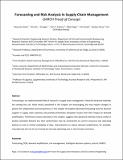| dc.contributor.author | Datta, Shoumen | |
| dc.date.accessioned | 2008-12-18T12:21:37Z | |
| dc.date.available | 2008-12-18T12:21:37Z | |
| dc.date.issued | 2008-12-18T12:21:37Z | |
| dc.identifier.uri | http://hdl.handle.net/1721.1/43948 | |
| dc.description | Making sense of data may benefit from high volume data acquisition and analysis using GARCH and VAR-MGARCH (Datta et al 2007) techniques in addition to and in combination with other tools for forecasting and risk analysis in diverse verticals that may span from healthcare to energy (Datta 2008e). In this work, we explored the possibility of using advanced forecasting methods in context of supply chains and demonstrated financial profitability from use of the GARCH technique. It remains unexplored if concomitant business process transformation may be necessary to obtain even better results. The proposed advanced forecasting models, by their very construction require high volume data. Availability of high volume data may not be the limiting factor in view of the renewed interest in automatic identification technologies (AIT) that may facilitate acquisition of real-time data from products or objects with RFID tags or embedded sensors. It is no longer a speculation but based on proof that use of advanced forecasting methods may enhance profitability and ICT investments required to acquire real-time data may generate significant return on investment (ROI). However, understanding the “meaning” of the information from data is an area still steeped in quagmire but may begin to experience some clarity if the operational processes take advantage of the increasing diffusion of the semantic web and organic growth of ontological frameworks to support ambient intelligence in decision systems coupled to intelligent agent networks (Datta 2006). To move ahead, we propose to bolster the GARCH proof of concepts through pilot implementations of analytical engines in diverse verticals and explore advanced forecasting models as an integrated part and parcel of real-world business processes and systems including the emerging field of carbonomics (Datta 2008f). | en |
| dc.description.abstract | Proof that application of GARCH technique offers potential for profitability. Forecasting is an underestimated field of research in supply chain management. Recently advanced methods are coming into use. Initial results presented in this chapter are encouraging, but may require changes in policies for collaboration and transparency. In this chapter we explore advanced forecasting tools for decision support in supply chain scenarios and provide preliminary simulation results from their impact on demand amplification. Preliminary results presented in this chapter, suggests that advanced methods may be useful to predict oscillated demand but their performance may be constrained by current structural and operating policies as well as limited availability of data. Improvements to reduce demand amplification, for example, may decrease the risk of out of stock but increase operating cost or risk of excess inventory. | en |
| dc.description.sponsorship | MIT | en |
| dc.language.iso | en | en |
| dc.subject | Forecasting, SCM, demand amplification, risk management, intelligent decision systems, auto-id, GARCH | en |
| dc.title | GARCH PROOF OF CONCEPT _ UPDATED 18 DEC 2008 | en |
| dc.title.alternative | Forecasting | en |
| dc.type | Book chapter | en |
